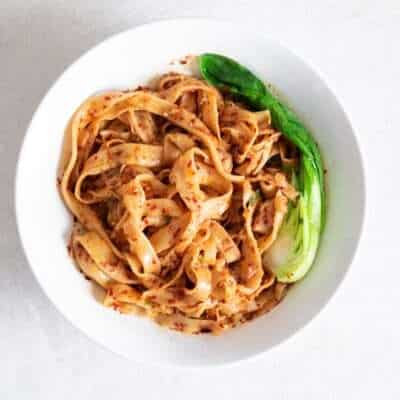Biang Biang Noodles (Chinese Hand-Pulled Chili & Garlic Noodles)

Biang Biang Noodles – Homemade Chinese noodles with a garlicky chilli oil, all made from scratch. In their simplicity lies an enormous power to let a few aromatic ingredients shine and bring colour to a dish. It is said that they get their name, Biang Biang Noodles, from the sound it makes when the chef slaps the dough onto the worktop while stretching them out.
serves 2
Ingredients
-
250g all-purpose flour
-
1 pak choi
-
2 spring onions
-
2 garlic cloves
-
1/2 tsp sichuan pepper
-
2 tbsp chilli flakes
-
2 tbsp soy sauce
-
1 tbsp black rice vinegar
-
5 tbsp vegetable oil (or another neutral oil)
Method
For the noodles, mix the flour with 140ml water and 1/2 salt and knead into a rough dough. Cover with a towel and let it rest for 10 minutes. This will hydrate the flour, which develops the gluten and makes it much easier to handle the dough. Then knead it for 10 minutes until you can stretch a piece of dough into a thin sheet without ripping. If it does rip, let it rest a little bit longer and knead it for another 5 minutes. Divide the dough into 8 equal pieces and shape each piece into a thick sausage. Then coat each piece with vegetable oil. Place them on a plate, cover with a towel and rest for 1 hour in a warm environment (for instance the oven with just the light setting switched on). Roll out each piece into a long thick strip. Then press a chopstick into the middle to make an indent. Pull and slap the dough into a long, thin noodle. Then, using the indent, tear each dough along the middle into one long noodle loop.
Half the pak choi, finely chop the spring onions and crush the garlic. Toast the Sichuan pepper in a small frying pan until fragrant (30 seconds) and grind into a fine powder. Cook the noodles in seasoned boiling water for just 1 minute. Then remove the noodles and place them into a deep heat-proof bowl. Add the pak choi to the boiling water and blanch for just 30 seconds. In the meantime, sprinkle the spring onions, garlic, Sichuan pepper and chilli flakes right on top of the noodles. Heat the oil until it begins to smoke and pour over the aromatics, aiming for the chilli and garlic. Add the soy sauce and vinegar and stir everything to combine. Then divide into two portions.

Biang Biang Noodles
Ingredients
- 250 g all-purpose flour
- 1 pak choi
- 2 spring onions
- 2 garlic cloves
- 1/2 tsp Sichuan pepper
- 2 tbsp chilli flakes
- 2 tbsp soy sauce
- 1 tbsp black rice vinegar
- 5 tbsp vegetable oil (or another neutral oil)
Instructions
- For the noodles, mix the flour with 140ml water and 1/2 salt and knead into a rough dough. Cover with a towel and let it rest for 10 minutes. This will hydrate the flour, which develops the gluten and makes it much easier to handle the dough. Then knead it for 10 minutes until you can stretch a piece of dough into a thin sheet without ripping. If it does rip, let it rest a little bit longer and knead it for another 5 minutes. Divide the dough into 8 equal pieces and shape each piece into a thick sausage. Then coat each piece with vegetable oil. Place them on a plate, cover with a towel and rest for 1 hour in a warm environment (for instance the oven with just the light setting switched on). Roll out each piece into a long thick strip. Then press a chopstick into the middle to make an indent. Pull and slap the dough into a long, thin noodle. Then, using the indent, tear each dough along the middle into one long noodle-loop.
- Half the pak choi, finely chop the spring onions and crush the garlic. Toast the sichuan pepper in a small frying pan until fragrant (30 seconds) and grind into a fine powder. Cook the noodles in seasoned boiling water for just 1 minute. Then remove the noodles and place them into a deep heat-proof bowl. Add the pak choi to the boiling water and blanch for just 30 seconds. In the meantime, sprinkle the spring onions, garlic, Sichuan pepper and chilli flakes right on top of the noodles. Heat the oil until it begins to smoke and pour over the aromatics, aiming for the chilli and garlic. Add the soy sauce and vinegar and stir everything to combine. Then divide into two portions.
Notes
- If you want to save some time, look for “knife-cut” noodles in your local Asian store for a great alternative to homemade ones.
- This dish becomes more colourful and fragrant if you crush your own chillis. Just buy some whole dried chillis at your Asian store, toast them in a hot pan for 30 seconds and use a spice grinder to crush them into flakes.
